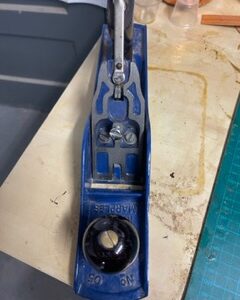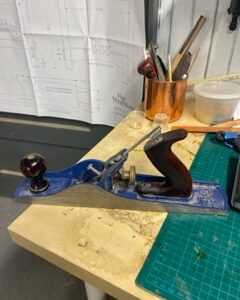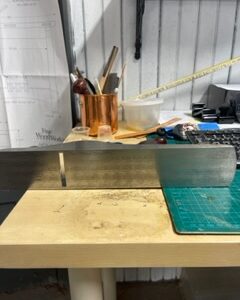Is this 40 year Record Marples plane worth rehabbing?
My brother-in-law recently gifted me this 40 year old number five Record plane that he never really used. I sanded the rust off of the bottom and it seems to be in really good shape. I haven’t heard people mention this brand, so I’m wondering if it’s bones are good enough to merit buying a Hock blade and chip breaker to use in my general woodworking. I’ve done very little hand plane work and was going to save up and get a Lie- Neilsen but if others think this is a decent plane, I’ll probably try and get this up to snuff.

















Replies
I have 3 Records in my kit and they all perform well with the original irons. Go for it.
Thanks -mj-, good to get some confirmation.
There is on the FW site a really good video by Rollie Johnson on how to setup/ rehab planes. A little trick with grinding compound that i never thought of before. If as you say it was hardly used you probably won't need to spring for aftermarket parts but as it was not used its likely to have never been tuned ,set up,flattened in the first place. Watch the movie... Everything you need you may already have.
Thanks pantalones868 I will give it a view.
For a number 5, I wouldn't spend on an aftermarket blade. Lear to sharpen and set it up, and it will make a fine jack plane. Save the money and put it toward a Lie Nielsen 3 or 4 smoother.
Thanks, for the tip john_c2. Saving money is always appreciated.
Paul Sellers has some excellent YouTube videos on how to rehab a plane. I have both vintage and LieNielsen planes. I like them both and have a slight preference for the vintage ones as they weigh less. I also prefer the thinner vintage blades. I do have a Hock blade and a Hock spokeshave. If I wore out my vintage blade, I would consider a Hock blade as long as I could get it made to the same thickness (or should I say thinness) as the vintage one.
Thanks joeleonetti, I’ll sharpen this vintage blade and see how it works. BTW the clock videos you recommended were excellent; I’ve made a couple to great reviews.
If you follow Paul Sellers he an advocate of the Stanley/Bailey hand planes on which your Record plane is based. Record, in England made tools as good or maybe better than Stanley. According to Paul, any of these planes with proper fettling, sharpening and setup can perform as well as a Stanley Bedrock style plan on which the Lie Nielsens are based.
The thinner Stanley blades are often bi-metallic, that is two different steel compositions welded together, and I suspect the Record versions are as well. One layer, which extends to the tip of the blade is a harder composition with better edge retention and the other is a softer, tougher composition. You can see this as a slight difference in color that becomes apparent as you sharpen the blade.
Most of the chatter that people complain of with thin blades and Bailey planes arises from the plane never having been fettled correctly by previous owners or set up correctly by the current one. Whereas Lie Nielsen takes extreme care with fit and finish (and prices their tools accordingly - and they are worth every penny) the Stanley and Record planes while perhaps fine off the shelf for basic carpentry like fixing a squeaky door were likely meant to be fine tuned by the user if they were intended for more challenging tasks as in cabinetmaking.
There are many sources for this info. Aside from Paul Sellers you can also get a detailed and comprehensive video on the topic from Roland Johnson here on the FW site:
https://www.finewoodworking.com/videoworkshop/2021/01/restoring-vintage-handplanes-with-roland-johnson
I have a collection of Stanley/Bailey type planes and over the course of a week I was able to get a full set of all the sizes working beautifully following Rollie's lessons. One plane would take less than a day. And once properly set up, it becomes easy to maintain them with a quick hone as they dull during use.
Thanks for the detailed explanation ct_engineer. After all the favorable comments, I am committed to try and tune it up at this point.
There is , at least to me, something very satisfying about using a very fine tool. Record at the time of the vintage of yours had a really good reputation. I don't have experience with Record planes but I have used other Record stuff and it was high quality. It seems everybody has been bought by somebody so I don't know about Record today. I have Stanley planes primarily,all or most pre WW ll and quite a few of them and I consider them to be a very fine and a pleasure to work with tool. I'm pretty complete on bench planes for example and although I acquired them over years, sometimes replacing one with a better one that I came across I don't think in total my out of pocket cost was much more than the cost of one Lie Nielson. I look on online auctions and Craigslist and it's pretty clear that shopping carefully you can end up with several good planes for the cost of one Lie-Nielson.
Beyond that I see no work being done today that is better than the work of the woodworkers of the past. Maloof, Frid ,Nakashima, Allen Peters etc. never had a Lie-Nielson plane. I've used them and a LIE-NIELSON is a very sweet plane, but with the extraordinary costs today associated with putting together an adequate tool chest and the terrific savings associated with the fine quality of some of the old tools that can be had at bargain prices ---. Some old tools are considered collector items, and some people think that things like a Stanley #4 must be collectable as well because its old and ask unreasonable prices ,but for most of these tools that your likely to use other people used them as well so consequently there are scads of those tools out there! You already got one for free, so there you go!
Thanks for the encouragement pantalones868
I have a Record #7 that I bought in the late 1970s. It worked well till I tuned it up thoroughly, at which time it worked very well. A couple years ago I flattened the soles of all my old planes (the rest are Bedrocks or Baileys) and all work much better now.
I have flattened the soles and nice to have confirmation on what a difference it can make.
If you follow Rollie Johnson's guidance the most important thing to eliminate chatter (after flattening the sole) is to 1) establish good contact between the frog and the sole 2) to establish good contact between the blade and a flattened plane on the frog 3) to set the frog in the proper location on the sole for the work you intend to do. All these are far from a given on an as-manufactured plane (other than high end planes like Lie Nielsen, etc.)
After watching the Roland Johnson videos, those seemed to the crucial aspects that he emphasized as well so I will be sure to get some valve grinding liquid and camellia oil to address those areas.
Just finished de-rusting and fettling this set for sale. I use veritas Bevel up planes and some rehabbed canadian stanleys in daily use. These perform just as well. I do prefer them with veritas irons and chip breakers. Just a little more solid feeling. At $100 canadian a plane and $100 for the new blades still a solid deal.
They look similar to the Record I have.